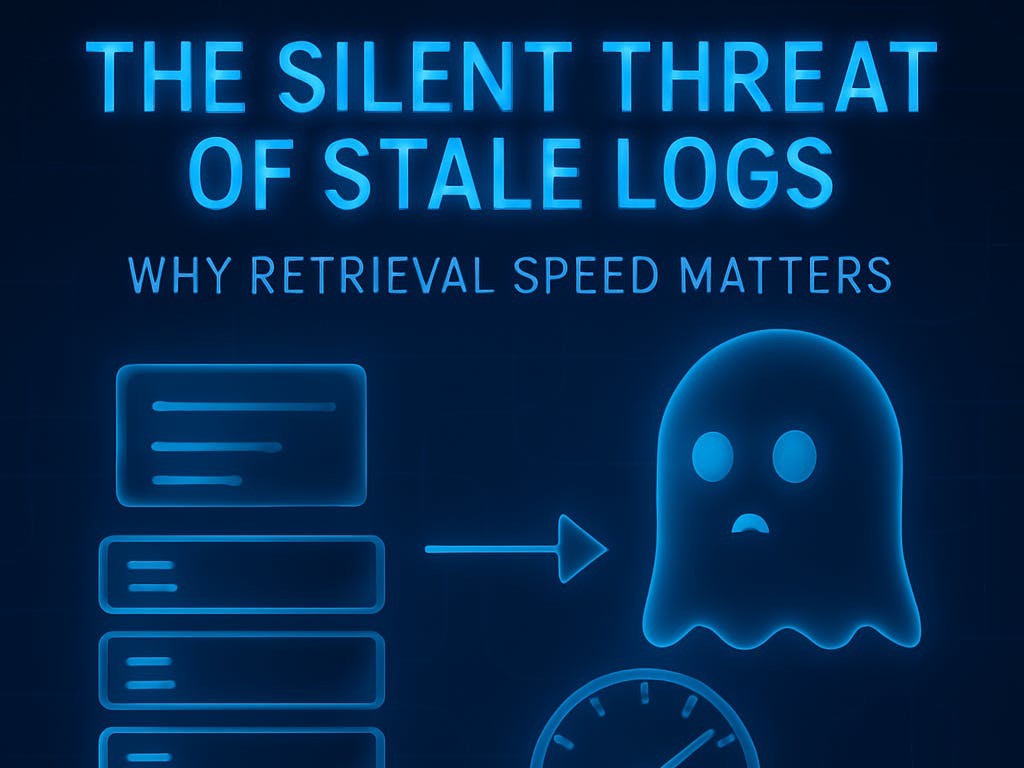The Silent Threat of Stale Logs: Why Retrieval Speed Matters
Aug 2, 2025

In today’s DevOps and security environments, logs are the backbone of observability, but only if they’re fresh. Stale logs (delayed, incomplete, or hard to retrieve) hide what’s really happening in your systems. They create blind spots, slow down incident response, and leave room for attackers or outages to do more damage.
It’s easy to overlook the timeliness of logs because teams often focus on what they capture: errors, warnings, traces, or events. But the real value lies in how quickly those logs surface when they’re needed most. This post explores why retrieval speed matters, the risks of stale logs, and practical ways to design for fast, reliable access.
The Risks of Stale Logs
Even short delays in log visibility can snowball into bigger problems:
- Slower response: If logs arrive late, responders are “fighting blind.” Imagine an attack that begins at 1:00 PM, but monitoring only sees the relevant logs at 1:30 PM. That’s a 30-minute head start for the attacker. In incident response, those lost minutes often decide whether you contain an issue or watch it spiral.
- Longer downtime: Every extra minute of MTTR (mean time to resolution) translates into customer frustration, SLA breaches, or lost revenue. Without quick access to logs, engineers spend more time guessing and less time fixing.
- Missed threats: Many cyberattacks unfold in hours, not weeks. If your SIEM or detection tools are processing stale logs, brute-force attempts, insider anomalies, or privilege escalation events can slip through entirely.
In short, stale logs don’t just reduce efficiency; they actively increase risk.
Why Speed Matters
Fast log retrieval changes the outcome of incidents.
- Real-time alerting: Fresh logs mean anomalies trigger alerts instantly, spikes in error rates, failed login attempts, or sudden traffic surges. This early warning system prevents escalation before users or systems feel the impact.
- Faster fixes (lower MTTR): Engineers don’t waste precious time waiting for logs to propagate. Efficient indexing and high-speed access surface clues quickly, allowing fixes or rollbacks within minutes.
- Better security (lower MTTD): Mean time to detect (MTTD) matters just as much as MTTR. Rapid retrieval lets analysts correlate suspicious events across systems immediately, cutting attacker dwell time and reducing damage.
- Reliable systems: Observability is only as strong as its weakest link. With fresh logs, small anomalies, rising latency, resource spikes, and failing requests can be spotted early and corrected before they ripple into outages.
Where Log Latency Hurts Most
Microservices & Cloud-Native Systems
Modern applications rarely live in one place. They’re spread across dozens of microservices, containers, and serverless functions. Each component logs independently, but the real story emerges only when those logs are pieced together.
If logs aren’t centralized and streaming in real time, debugging feels like chasing shadows. A user transaction might fail because of a downstream service, but if backend logs arrive late, engineers could waste hours hunting in the wrong service. In fast-moving cloud environments, even a few hours of delay is unacceptable.
Real-time aggregation ensures logs from short-lived containers or ephemeral environments aren’t lost when instances terminate. Without this, visibility gaps grow wider, and critical evidence disappears.
CI/CD Pipelines
Logs also play a vital role in development velocity. Build, test, and deploy logs are the heartbeat of continuous delivery. If failures are buried in a build server and discovered hours later, entire teams lose time, or worse, faulty code gets promoted to production.
Immediate log feedback keeps pipelines flowing smoothly. Failed tests or broken deployments trigger alerts the moment they occur, allowing teams to fix issues before they cascade downstream. In production, fresh deployment logs enable quick rollbacks when errors spike after a release.
Best Practices for Faster Log Retrieval
Designing for log speed isn’t about over-engineering; it’s about ensuring teams can act when it matters. Here are practical ways to keep logs fast and useful:
- Index smartly: Organize logs by fields like timestamp, level, and service so queries don’t scan everything blindly. This makes terabytes of data searchable in seconds.
- Cache recent data: Keep “hot” logs in memory or SSD storage for sub-second access. For most incidents, it’s the last few hours of data that matter most.
- Tier your storage: Store recent logs in fast, indexed storage while archiving older data cost-effectively. This balances performance with compliance needs.
- Stream ingestion: Build pipelines that push logs in real time. Avoid bottlenecks where logs pile up before being indexed.
- Use structure and context: JSON formats, metadata tags, and correlation IDs make log queries sharper and faster. They also let teams pivot quickly across services, sessions, or users.
Why It’s a Business Issue Too
It’s tempting to treat stale logs as just a technical nuisance, but the costs ripple outward:
- Downtime costs: Every extra minute offline translates to lost revenue, especially in industries like e-commerce or financial services.
- Compliance gaps: Many regulations require timely log analysis. Stale logs can mean missed reporting deadlines or audit failures.
- Team fatigue: Nothing burns out engineers faster than “flying blind” in an outage, waiting for the system to tell them what’s wrong.
In other words, log speed isn’t only an engineering concern; it directly affects business resilience, compliance, and customer trust.
What if cold logs were just as fast?
Most teams treat cold log storage as a trade-off: it’s cheaper, but painfully slow to search. That’s why stale data creeps in, once logs move to cold storage, they’re effectively out of reach during an incident.
At CtrlB, we designed an architecture that eliminates this trade-off:
- Disk-less, lake-first design: logs live in durable blob storage from day one.
- On-demand compute with micro-indexing: even cold data can be retrieved in sub-second time.
- Schema-less search: so you don’t need to pre-model logs before querying at scale.
The result: logs never really go stale. Whether it’s data from last hour or last year, retrieval is equally fast, making cold storage just as actionable as hot.